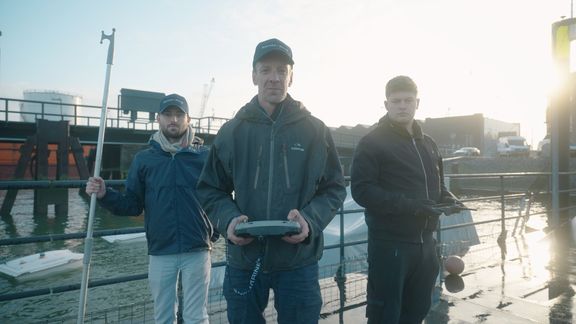The shark that collects waste and data
If you look carefully, staring at the water, you will see it: a shark with a huge open mouth. But no fish, plankton or unsuspecting swimmers disappear into this shark's mouth: the WasteShark catches plastic and other waste. RanMarine’s promising prototype has developed into a mature water robot that cleans water worldwide. Creator Richard Hardiman: ‘I am an inventor, I enjoy turning ideas into actual solutions.’
The idea for the WasteShark originated in South Africa, where Hardiman comes from. ‘I saw two people fishing rubbish out of the water with a fishing net. I thought: surely there must be a different and better way of doing that? A product that can clean up waste without anyone being present. Around the same time, I became a father and developed an interest in sustainability. I wanted to do something good, also in terms of work. And that’s how the idea for the WasteShark was born. I have an engineering background so I started building. In 2016 I came into contact with the PortXL programme that allowed me to develop my idea as part of my newly established startup RanMarine.’
Water robot
Hardiman ended up at RDM Rotterdam, where he continued to develop his shark: ‘The WasteShark is a mini-water robot that floats and can navigate autonomously. It scours the surface of the water for plastic, waste and pollution and other things that do not belong in the water. The WasteShark collects it in its ‘open mouth’ and brings it to the shore. The smart shark can also pick up natural material that impacts water quality, such as duckweed, algae and aquatic plants. In addition, the WasteShark collects data on water quality. For example, it can monitor whether outboard water is suitable for swimming.’
Practical
How large and heavy is the shark? Hardiman lists the specifications: ‘The WasteShark is controlled via 4G, has a range of 3 kilometres, reaches a speed of 3 kilometres per hour and can swim for about 6 hours. The water robot is 1.57 metres long, 1.09 metres wide, 52 centimetres high and weighs 75 kilos. Very manageable in other words.’
Easy to use
There are several people and organisations whose models retrieve waste from the water. How is WasteShark different from other solutions? Hardiman: ‘It is simple, elegant and efficient. It is emission-free and does not result in any other pollution in the water, and it is easy to deploy. That was also our aim. We wanted to design a tool that collects as much waste as possible in a simple and manageable way, and can be used easily and by as many people as possible. If you have a fairly large car, you can even transport it in the boot. So it's user-friendly for a wide audience.’

WasteSharks are now swimming around the world: from South Korea, Australia, United States and the UK to the Netherlands. They are used in marinas, industrial ports, in the tourism sector, and by governments or organisations such as the World Wildlife Fund and the United Nations that want, for instance, to keep canals, lakes and rivers clean.
Millions of sharks
How does Hardiman see the future? ‘I am not against plastic, it is a convenient product. But we do have a huge mountain of plastic waste entering the environment. It’s all about how to recycle plastic even better. We can make great strides in that and the WasteShark can contribute. My dream is to have millions of WasteSharks active all over the world. Not only to collect waste, but also to collect data. We need to know what is in our water and not just what is floating on it. Using that data, we can learn how to improve and maintain the quality of the water!’
Springboard
What does Rotterdam mean to Hardiman? ‘My original idea was to return to Cape Town, but the Port of Rotterdam is a springboard to the world of robotics and engineering. And there’s a strong network of companies here committed to sustainability worldwide. This will allow us to improve the WasteShark even further and expand its distribution. I started out on my own and now we have grown into a company with 25 people, thanks to Rotterdam. I am glad I stayed, because without the Port of Rotterdam, RanMarine would not be here!’